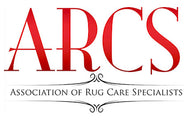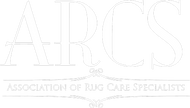June Newsletter 2015
JUNE 2015 NEWSLETTER
Technical Committee
The ARCS technical committee exists to collect technical information and disseminate this information to ARCS members and consumers. The committee held it's first meeting at the annual meeting in New Orleans and has continued to hold discussions about how to implement it's mission statement. As it's first order of business, an updated series of consumer fliers (available below). These fliers can be printed out and handed out to your customers or can act as simple references for your employees. One of the long term projects for the committee is to establish a digital cleaners library, that would be accessible to all ARCS members. There are a number of logistical challenges to doing this but the benefit to members would be significant and we worth the effort.
Use of Chlorine on Wool in a Historical Context

Recently, chlorine and its use on wool rugs has been a hot topic. Is chlorine a tool of reckless and unethical rug cleaners or one of many tools for the experienced rug washer? I won’t tackle that question here but I thought this might be refreshing break to look at the historic use of chlorine in textile production with wool during the 19th and 20th centuries.
In 1774 Swedish pharmacist Carl Wilhelm Scheele released a few drops of hydrochloric acid on a piece of manganese. A greenish-yellow gas arose from the reaction and chlorine was discovered. Chlorine wasn't identified as an element or named until 1810 when chemist Sir Humphry Davy gave it the name "chloric gas" or "chlorine". Chlorine is a naturally occurring element usually found bonded to other elements in rocky compounds and in all of the oceans around the world and is a principle component in the salt we eat every day (NaCl). Chlorine was first used as a disinfectant in the mid-19th century and by the early 20th century found its way into municipal water supplies to disinfect drinking water. These two applications have saved untold millions from sanitation and water borne diseases.
Treating of wool with chlorine is not new. Its commercial application existed in the 19th century and continues through to today. Chlorinating processes and products went by a variety of names and formulations including Lluster Wash, Superwash, Drisol , Harriset, Hercosett, Hypol Kroy, and Kelpie to name a few. The earliest written commercial application of chlorine on wool I have encountered is in “A Manual of Dying” by Loewenthal 1893 where a chlorinating process was used to improve the absorption of mordants and dyes. The treating of wool with chlorine prior to dying was considered an important pretreating process. Its use on wool prior to dying was standard practice and improved dye absorption particularly with dark colors. Some of these chlorinating solutions were very strong at 30% chlorine in cold water for brief periods of time. The wool was then treated with acid to reduce deterioration and yellowing of wool. In addition to improving dying, chlorine compounds are used on wool to soften and improve the handle of the finished product by chemically buffing scales and to reduce felting as well as shrinkage. These treatments are so successful that even today Woolmark states that some 30 million kilograms of wool undergo the chlorine treatment annually.
Whether or not chlorine is appropriate to use in a cleaning context is another discussion for another time. The commercial use of chlorine on wool textiles from clothing to rugs for the last 122 plus years is a matter of historical fact and not unique nor particularly unusual.
Randy Hyde
Renaissance Rug Cleaning Inc
Succession Planning for Our Family's Small Business

SUCCESSION PLANNING? RETIREMENT?
Bah Humbug! My husband and I are both in our 70s and still go to work every day. It is our home away from home where we continue to pour our blood and guts and passion into our small family business just as we have over the last 40+ years. The real world of the entrepreneur is not the one glorified by others as ‘going into business for yourself.’ It takes guts, tenacity, and a belief that the risks are not as great as they really are. My husband started this enterprise back in 1971 and it changed the course of our family forever.
THE GRADUATION EPIPHANY
Last Sunday, as we sat awaiting the commencement ceremony to begin, signaling the college graduation of our youngest child, we had plenty of time to ponder our situation. We are truly blessed. The economy is not good but our business has continued to thrive. We brought up 8 children and this one, our soon-to-be most recent college graduate, has expressed her desire to come in and ‘take over’ the business. (The problem of multiple heirs all looking to run the business, possibly without the ability, is, thankfully, not ours. Nor is the spouse involvement present at this time.)
Our daughter has the passion. She has worked many years in the business. She is the one with the interest, the drive, the creativity, and the foresight to be able to grow the business into the future and let her poor, tired, (and old) parents ride off into the sunset of our lives—retirement aka the golden years! It is true and there is no denying it--We are now at the age where what was once our future is now our present!
THE FUTURE
But, why is it so hard to think the future will actually come to pass? As time goes on, our guts expand, our hair thins, and our children grow up. Why do we get so surprised when we find our blood pressure rising and our energy lessening? Our oldest child will be 50 this year and our youngest is 38. Two of our grandchildren are closing in on their 20s. All of these things, (and more), invariably come to pass and when they do, we shake our heads in wonder. But the future happens eventually to every one of us.
PLANNING FOR SUCCESSION and EVENTUALLY - RETIREMENT
The ideas of succession planning and retirement for our future have not been at the top of our concerns over the last few years but they have definitely been lurking in the background. Our dream, like those of many small business owners, has always been that our business will continue on to the next generation. But we knew our youngest child was really serious when she decided to return to college to get her degree in Business Management. While waiting for her to complete her studies, we have gradually 'cleaned up our act' quite a bit, bringing policies and procedures into the 21st century, ordering the latest equipment and technology, placing responsible people in charge of our workforce, expanding our market, etc.




